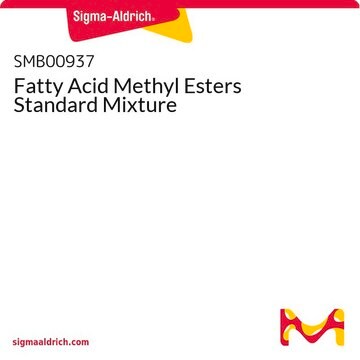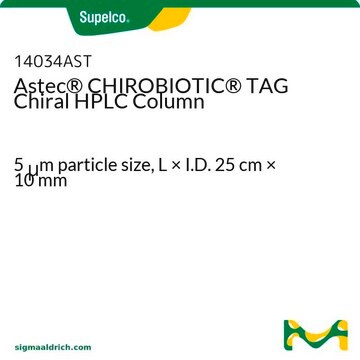53023AST
Astec® CLC-D Chiral (5 μm) HPLC Columns
L × I.D. 15 cm × 4.6 mm, HPLC Column
Sinónimos:
Chiral Separation CLC-D Column
Iniciar sesiónpara Ver la Fijación de precios por contrato y de la organización
About This Item
UNSPSC Code:
41115700
eCl@ss:
32110501
NACRES:
SB.52
Productos recomendados
product name
Astec® CLC-D Chiral HPLC Column, 5 μm particle size, L × I.D. 15 cm × 4.6 mm
material
stainless steel column
agency
suitable for USP L32
product line
Astec®
packaging
pkg of 1 ea
manufacturer/tradename
Astec®
parameter
0-50 °C temperature
172 bar pressure (2500 psi)
technique(s)
HPLC: suitable
L × I.D.
15 cm × 4.6 mm
matrix
fully porous particle
matrix active group
chiral bidentate ligand (D-form), requires 5 mM CuSO4 phase
particle size
5 μm
pore size
100 Å
operating pH
3.5-7
separation technique
chiral
Categorías relacionadas
General description
CLC columns use the copper ligand concept described by Davankov to effect enantiomer separation (1). The method uses a small, chiral bidentate ligand attached to the silica surface and a copper sulphate-containing mobile phase. The copper ions coordinate with the chiral selector on the stationary phase and carboxylic acid functional groups on the analytes to form transient diastereomeric complexes in solution. The technique also has the advantage of giving small acids with no UV chromophore a strong 254 nm signal. CLC columns are ideal for analysis of hydroxy acids, like lactic, malic, tartaric and mandelic acids, amino acids, other amines and bi-functional racemates, like amino alcohols. Proline and aspartic acid are particularly suited for low-level detection on the CLC column since the copper complex is detected at 254 nm UV. Both can be resolved on the CLC-D or CLC-L in 5 mM CuSO4 with the usual reversal of elution order from the CLC-D to CLC-L. In theory, any analyte that can complete the coordination with the copper ion can be resolved. Two versions of the column provide elution order reversal. On the CLC-D column, the L enantiomer generally elutes before D, with the exception of tartaric acid. The reverse is true on the CLC-L column where D elutes before L.
Features:
(1) Davankov, V. A.; Rogozhin, S. V. Ligand chromatography as a novel method for the investigation of mixed complexes: Stereoselective effects in a-amino acid copper(II) complexes. J. Chrom. A. 1971, 60, 284-312.
Features:
- Separates α-hydroxy carboxylic acids, amino acids and other α-bifunctional compounds
- High selectivity with simple mobile phases
- Copper complex gives strong UV 254 nm signal
- Simple reversal of elution order, CLC-L vs. CLC-D
- Excellent reproducibility
(1) Davankov, V. A.; Rogozhin, S. V. Ligand chromatography as a novel method for the investigation of mixed complexes: Stereoselective effects in a-amino acid copper(II) complexes. J. Chrom. A. 1971, 60, 284-312.
Legal Information
Astec is a registered trademark of Merck KGaA, Darmstadt, Germany
Choose from one of the most recent versions:
¿Ya tiene este producto?
Encuentre la documentación para los productos que ha comprado recientemente en la Biblioteca de documentos.
Badal C Saha et al.
Biotechnology and bioengineering, 82(7), 864-871 (2003-04-18)
Lactobacillus intermedius B-3693 was selected as a good producer of mannitol from fructose after screening 72 bacterial strains. The bacterium produced mannitol, lactic acid, and acetic acid from fructose in pH-controlled batch fermentation. Typical yields of mannitol, lactic acid, and
Enantiomeric impurities in chiral catalysts, auxiliaries, synthons and resolving agents. Part 2
Armstrong, Daniel W., et al.
Tetrahedron Asymmetry, 10 (1), 37-60 (1999)
Chromatograms
application for HPLCapplication for HPLCNuestro equipo de científicos tiene experiencia en todas las áreas de investigación: Ciencias de la vida, Ciencia de los materiales, Síntesis química, Cromatografía, Analítica y muchas otras.
Póngase en contacto con el Servicio técnico






